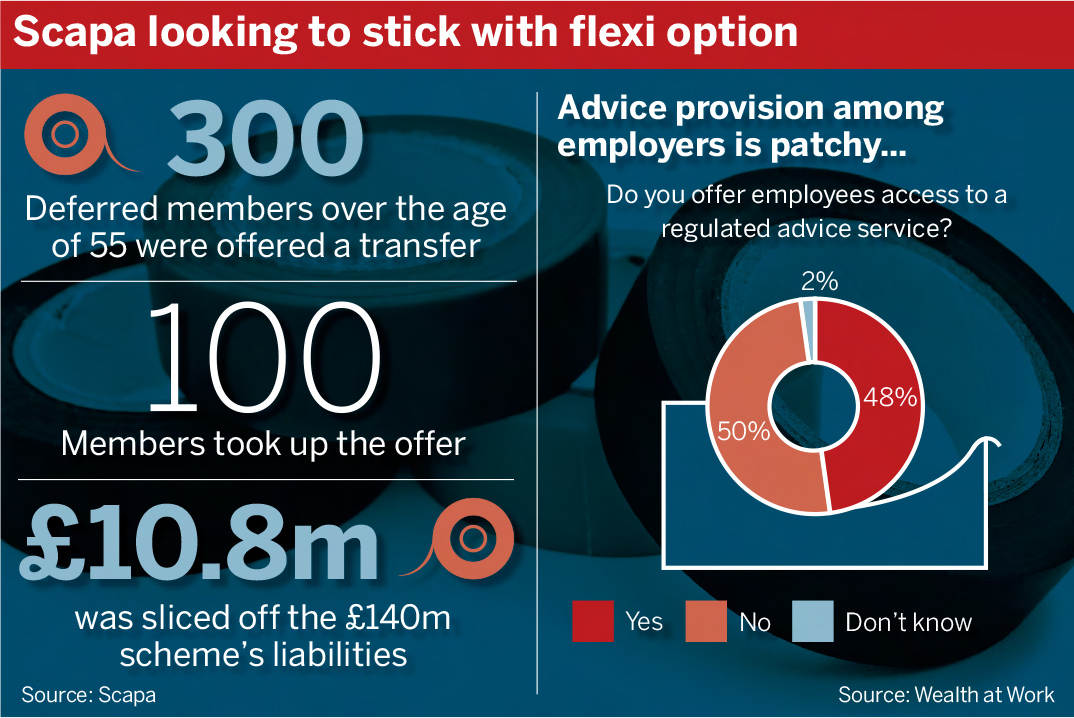Scapa saves £600k through flexible retirement exercise
Adhesive tape manufacturer Scapa Group has saved around £600,000 by offering flexible retirement options to some deferred members of its defined benefit scheme, clearing more than £10m of liabilities.
The introduction of freedom and choice has increased the appeal of defined contribution arrangements for many, which has in turn led to a rise in the number of DB members exploring transfers. Schemes have also seen the reforms as an opportunity to reduce their liabilities.
The Scapa Group plc Pension Scheme had around £140m in assets before it began the project in December last year.
The scheme has roughly 2,000 members, of whom 300 deferred members over the age of 55 were offered the flexible retirement option.
Around 100 of these took up the offer, with £10.2m of assets transferring out of the scheme as a result, settling liabilities of £10.8m.
Matthew Fowler, group financial controller for Scapa, said: “Our members are well informed about the new pension freedoms and this was our response to provide members with more flexibility that aligns to their specific personal circumstances.”
Scapa: Key stats
- The scheme has 2,000 members
- 300 were offered the option, 100 took it
- £10.2m of assets were transferred out, settling £10.8m of liabilities
Members who took up the option used their pots from the scheme to buy different benefits from private pension companies, he said.
It is one of a number of liability-management exercises the company has undertaken, and Fowler added the project was attractive “because it provides members with retirement options outside of the standard scheme offering”.
There were no enhancements added to the transfer rate, but members of the Scapa scheme who were offered the option were given access to one-to-one independent financial advice.
The scheme is now working to embed the option at retirement for all members, as well as exploring buyout options for different groups.
In its 2015 annual report, the scheme’s assets were valued at £162.2m on an IAS19 basis with obligations at £202m.
The key is pitching transfer values that are at a reasonable level that is appealing to the member and the scheme
Matthew Demwell, head of member options at consultancy Mercer, said flexible retirement options were commonly offered to the over-55 cohort of a scheme because “they can, if they want to, draw their benefits immediately… it makes the decision more immediate and concrete for people”.
For those under 55, schemes often offer enhanced transfer values, increasing the amount they would receive under normal circumstances.
“The key is pitching transfer values that are at a reasonable level that is appealing to the member and the scheme,” Demwell said.
Schemes carrying out bulk transfer exercises are required to offer members free access to independent financial advice. Demwell said providers often would not accept a transfer unless the member had received advice.
Clear communication
Ben Roe, partner at consultancy Aon Hewitt, emphasised the importance of clear communication with members when carrying out flexible retirement exercises.
Roe said: “With any exercise, you need to make sure that the communications are fair and balanced and that members can make an informed [decision]. Communication is really key.”
He said schemes would find details of what is required in the Pensions Regulator’s code of practice for incentive exercises.
“A lot of it is common sense, providing people with the information to make a decision. It’s about providing information, but not overloading people with information.”
Most Viewed
- What does Labour have in store for the pensions industry?
- LGPS latest: GLIL backers invest £475m for UK infrastructure push
- Dashboard costs rose by 23% in 2023, figures show
- Border to Coast launches UK strategy in major private markets push
- How the pensions industry can better support people with mental health problems


